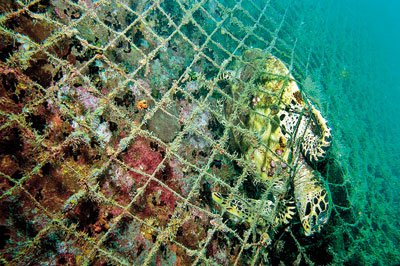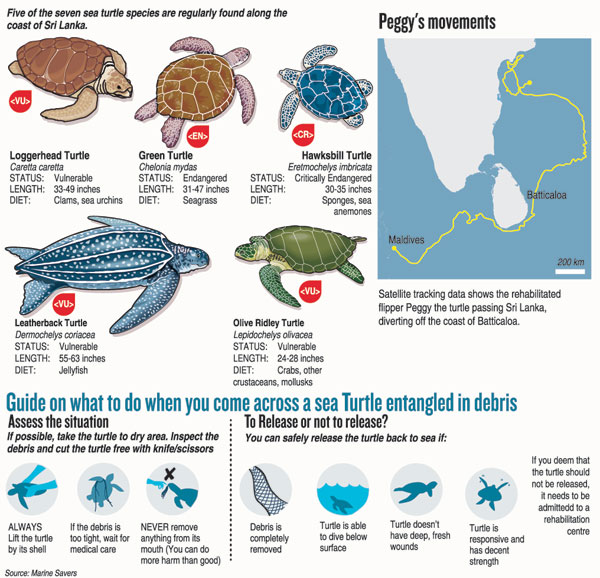News
Marine turtles get a second chance while nets still pose risks
View(s):By Malaka Rodrigo
Abandoned fishing gear in Sri Lankan waters continue to pose dangers to marine turtles, and there is little help on shore for creatures that are seriously injured. The bycatch remains problematic.
But, in nearby Maldives, a group is helping to rescue and rehabilitate injured marine turtles.
Three types of fishing gear have been identified as risks to sea turtles — gill nets, prawn/shrimp trawls, and longlines. Gill nets account for the highest number of entanglements. There are instances where fishermen themselves cut the flippers to protect their nets.

A sailor untangles the fishing net from one of the 13 turtles found off Batticaloa coast. Pix by Navy media
During a patrol on September 26, sailors of SLNS Samudura — once engaged in fighting terrorists — hauled in 13 turtles entangled in fishing nets about 10 nautical miles off Batticaloa. The creatures were later released.
Turtle expert Dr. Lalith Ekanayake of the Bio Conservation Society, who checked the images from that rescue, said they were Olive Ridley Turtles (Lepidochelys olivacea).
“These turtles were lucky. They were seen before any serious injury, but we sometimes find turtles that have suffered cuts to their flippers in their attempts to escape,” he said.

Fitting a satellite tracker to ‘Peggy’, a turtle rehabilitation success story. Photo: MarineSavers
A study by Prof. Rupika Rajakaruna of the University of Peradeniya about perceptions of fisherfolk and practices of turtle catches in 2020, found that most have experienced sea turtles being entangled in their fishing gear (78.5%), and that these were usually accidental (89.4%).
The study also found that fisherfolk involved in eating and/or selling turtle meat is significantly lower compared with the past. They are also not selling turtles for fear of the law but bycatch remains a problem.
Sugath Emmanuel, who heads a regional fisheries organisation in Kudawa, Kandakuliya in Kalpitiya said he recalled his father hunting sea turtles to sell the meat.
“But now, fisherfolks in our community are not bringing in any turtles as there are fines and the equipment can be confiscated,’’ he told the Sunday Times. “However, some do eat the meat of turtles caught in their nets. There are others who hand over injured turtles to wildlife officers.”
Regional veterinary surgeons of the Department of Wildlife Conservation (DWC) treat injured turtles.
Prof. Rajakaruna’s study found a large percentage of fisherfolk (61.4%) were unaware that sea turtles were air breathers. “This is important information as fisherfolk assume that the turtles caught in their nets are able to breathe underwater, and presumably leave entangled turtles in their fishing nets instead of removing them or reducing soak times,’’ Prof. Rajakaruna said.
Turtles can stay underwater for about two to five hours, but need to surface to breathe and they can die by suffocation when entangled in nets.
Dr. Suhada Jayawardane of The Wild Animal Rescue Centre in Aththidiya in Western Sri Lanka said the centre has received about 30 injured turtles this year.

A turtle trapped and killed in a ‘ghost net’. Photo: Umeed Mistry, Ocean Image Bank
“Most were entangled in fishing nets and got their flippers cut,’’ Dr. Jayawardane said. “If the cut is deep and infected, we sometimes must amputate the limbs. Turtles without one flipper can survive in the wild, but if many flippers are damaged, survival is difficult. Some turtles also have ‘buoyancy syndrome’, which makes diving impossible. Such turtles, too, must be taken care of.’’
Most regional wildlife offices don’t have facilities to care for injured turtles. So they give the animals to hatcheries. But, these facilities are also not adequate.
During a recent media workshop tour to the Maldives with the support of the Earth Journalism Network, the SundayTimes got a chance to observe turtle rehab.
MarineSavers, a conservation group active in the Maldives, rehabilitated over 450 turtles since 2010. Out of these, 75 of the animals had been Olive Ridley turtles and the rest consist of Green Turtles and Hawk’s Bill turtles, said Dr. Katrina Himpson, the veterinary surgeon of the turtle rescue and rehabilitation centre at the Four Seasons resort at the Landaa Giraavaru.
The vets also experiment with ‘environment enrichment devices’, such as floating pipes filled with food to stimulate foraging behaviour in the wild. According to MarineSavers, logs and other physical structures designed to provoke exploratory behaviours and provide tactile stimulation are also added to the turtle tanks.
Also being used is a structure made of pipes in the shape of a square with a rope around it. The turtles can manipulate it with their flippers, climb through it and rub their shells against it.
MarineSavers has sent a few turtles to large aquariums in other countries.
A turtle they rescued in 2014 and named ‘Peggy’ had lost a flipper and it had ‘buoyancy syndrome’. It could not dive. In 2016, it was sent to an aquarium in Belgium. After about two years, the turtle recovered its ability to dive. It was then airlifted to the Maldives and released in 2019.
Satellite-tagged data showed that ‘Peggy’ went all the way near India’s Odisha coast where thousands of Olive Ridley Turtles nest. Data also reveal that it swam in parallel to Sri Lanka’s south coast and then swam toward the deep seas somewhere near Batticaloa.
Dr. Ekanayake said in Kalpitiya the team will test a green LED light that had been experimented with elsewhere, to reduce bycatch. The LED is tied across gill nets. It is believed that turtles can see certain light wavelengths.
It was developed by John Wang, an ecologist for the National Oceanic and Atmospheric Administration of the USA (NOAA). Test results show up to 60% reduction in turtle bycatch. An Indonesian pilot project has reported a 20% boost in the target catch according to a World Wildlife Fund report.

The best way to say that you found the home of your dreams is by finding it on Hitad.lk. We have listings for apartments for sale or rent in Sri Lanka, no matter what locale you're looking for! Whether you live in Colombo, Galle, Kandy, Matara, Jaffna and more - we've got them all!

